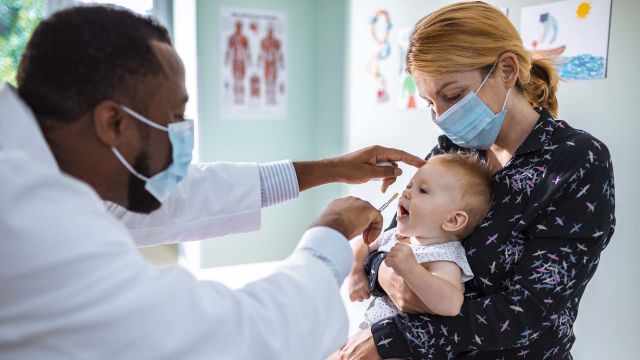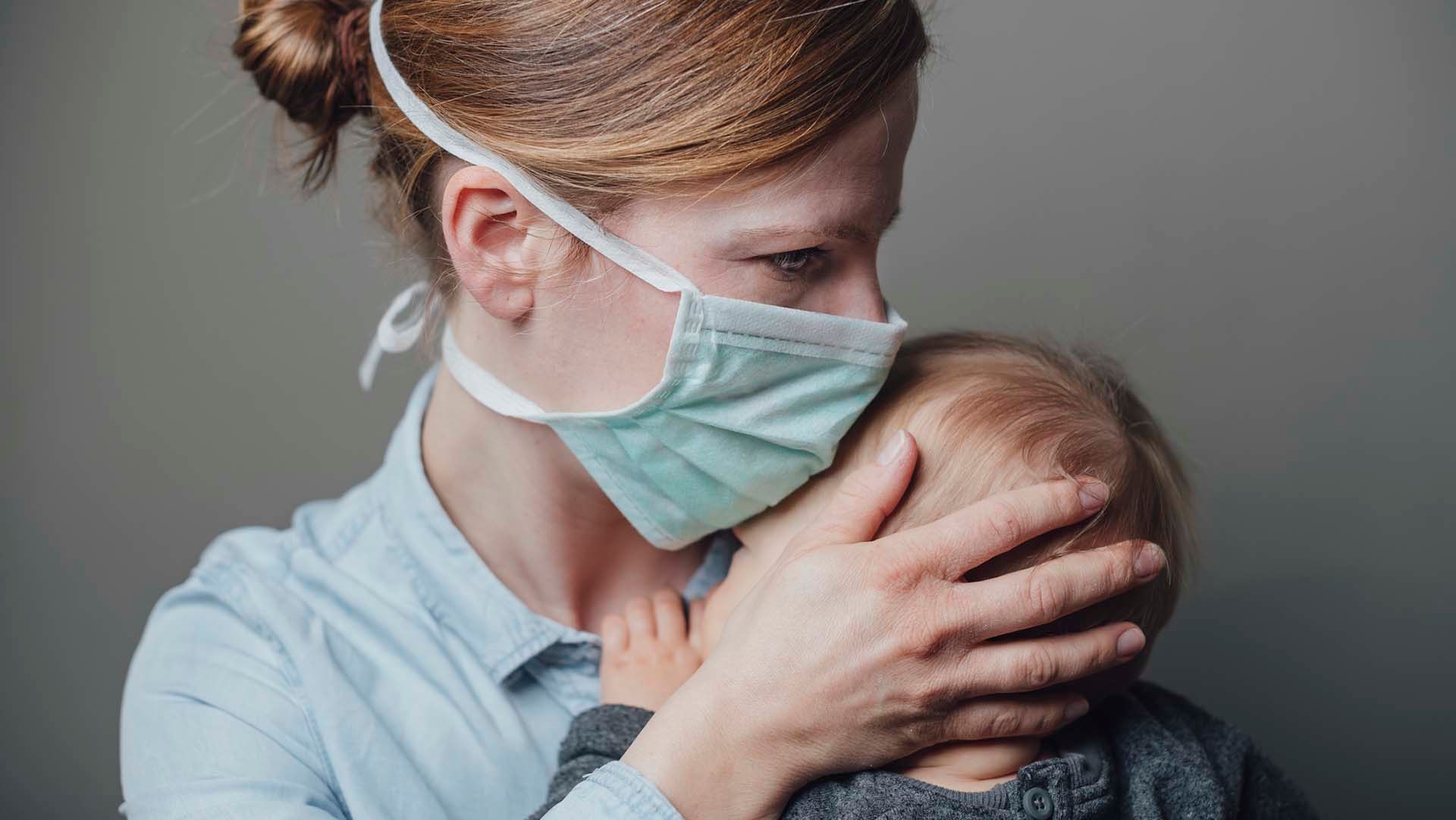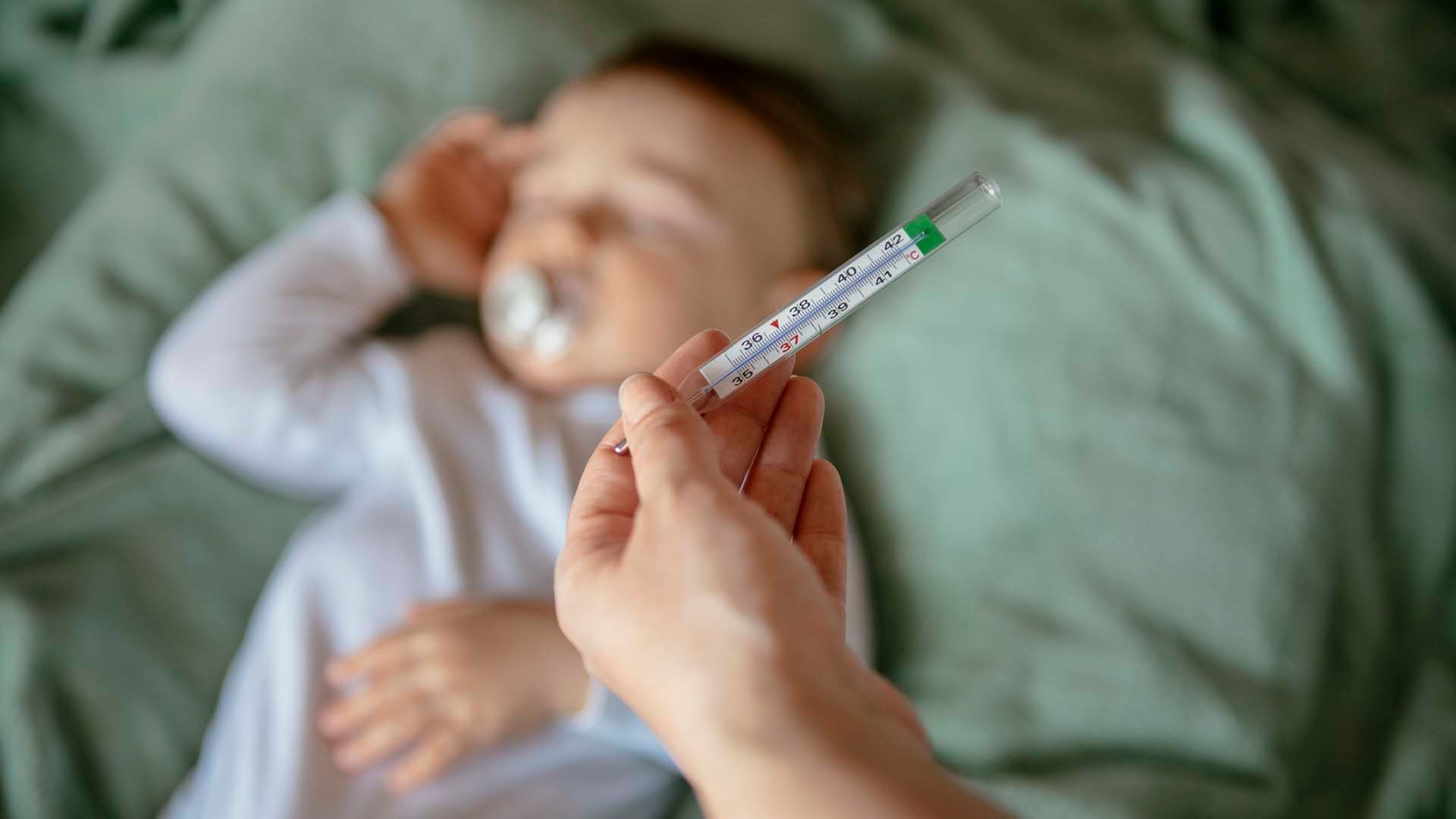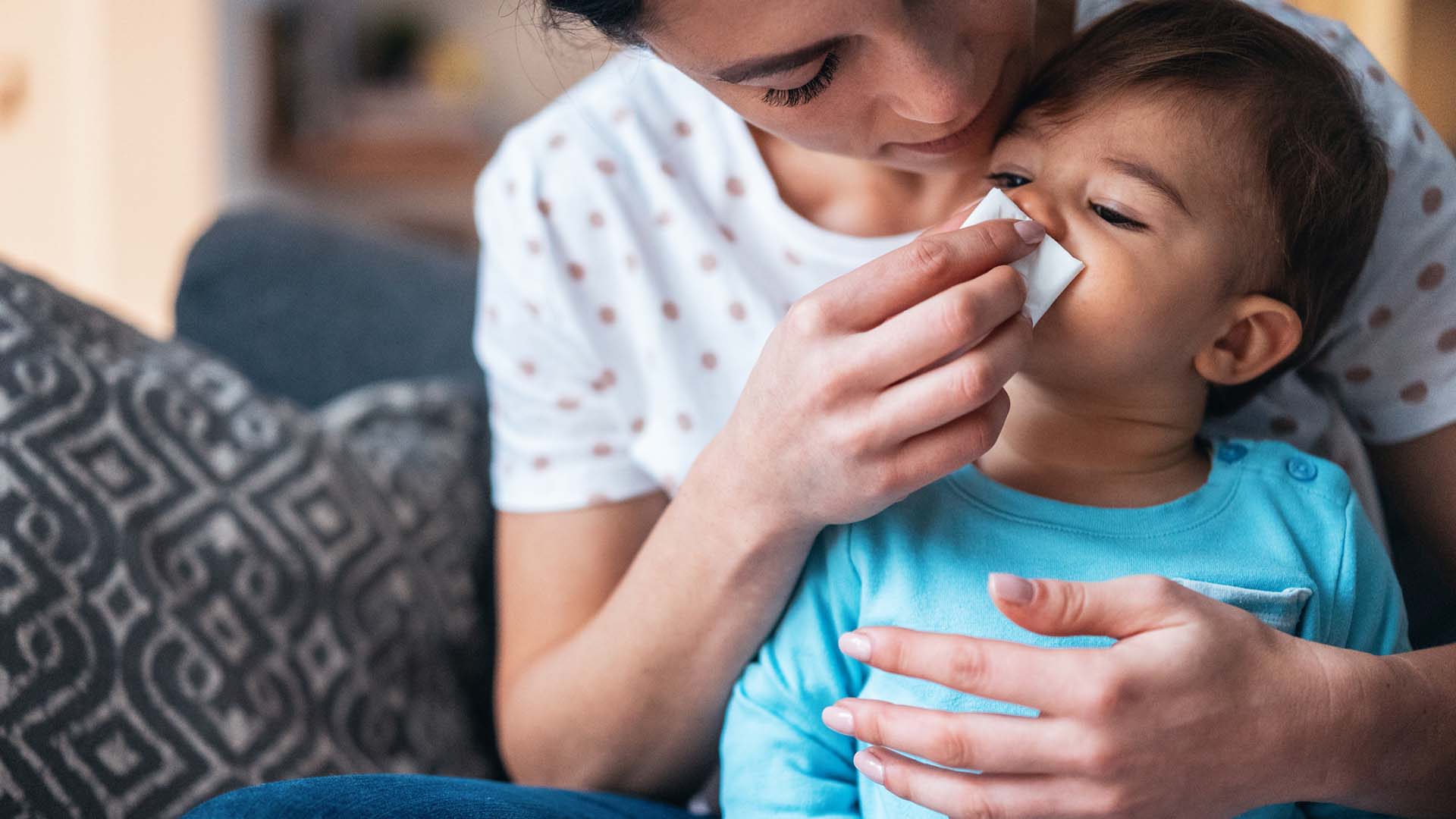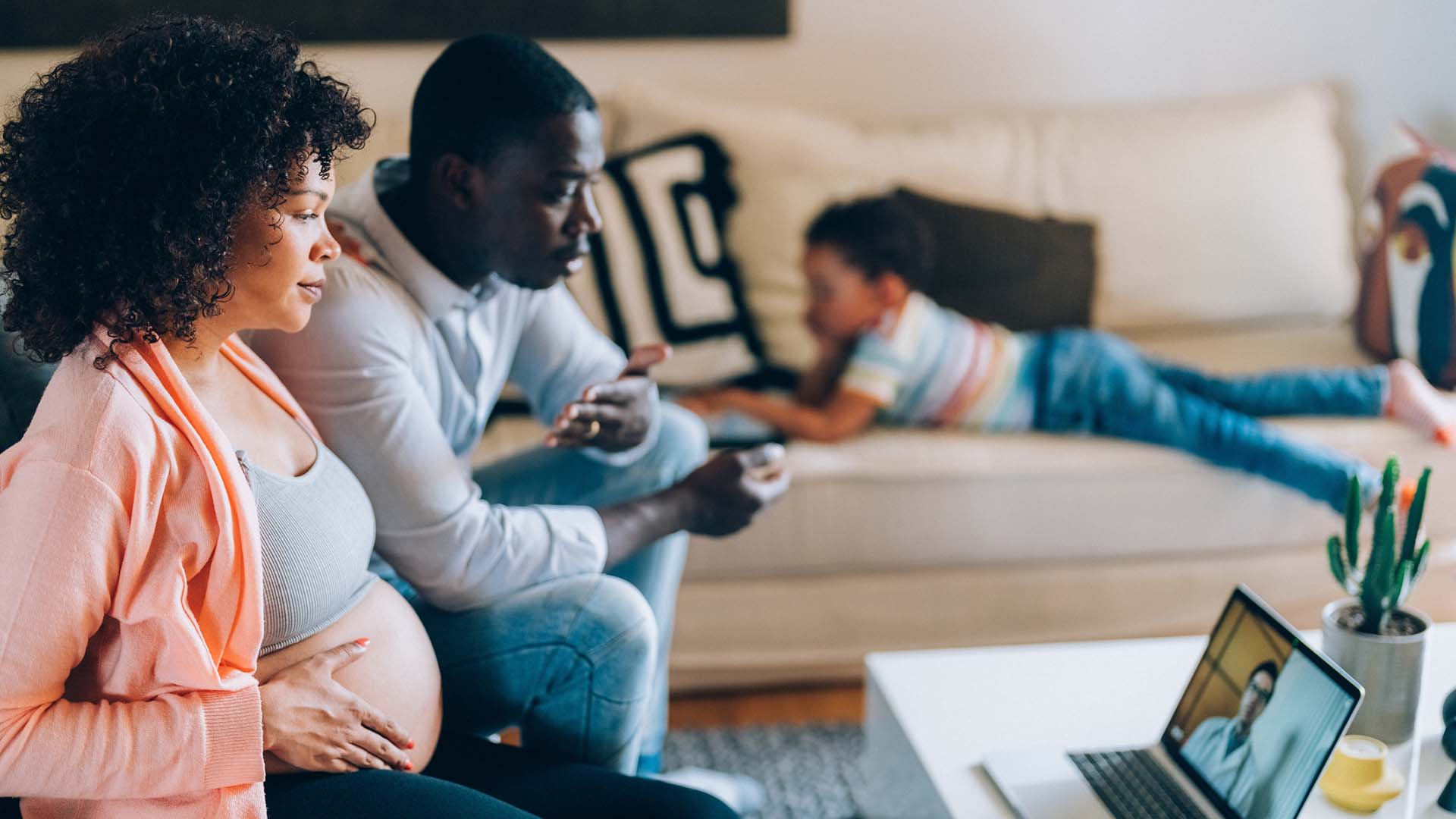Updated on September 11, 2023
Millions of people catch colds each year. For kids, it’s a practically endless cycle, since most will have between six and eight of these upper respiratory infections over the course of 12 months. Sometimes, however, especially among young children, the culprit behind the sniffling and coughing is actually RSV.
Though you may never have heard of it, respiratory syncytial virus (RSV), is a near-universal rite of passage, affecting almost every child before their second birthday. Much like the flu, it’s highly contagious and most active in the fall, winter, and spring in the United States and other parts of the Northern Hemisphere. Cases begin to rise in October or November, peaking in January or February and dwindling by April or May.
“We see a pretty seasonal surge, which is very classic,” says Purva Grover, MD, medical director of the pediatric emergency departments at the Cleveland Clinic in Ohio. “With the winters come a lot of holidays, and with the holidays come a lot of large crowds gathered together.”
Most RSV-infected children experience a simple cold, while otherwise healthy adults with an RSV infection often don’t show any symptoms at all. But for some, the virus can trigger serious complications, including bronchiolitis (inflammation of the lung’s small airways), pneumonia and respiratory failure.
Children and the elderly are especially vulnerable to RSV-related complications. Among children younger than 5 years old, the virus accounts for between 58,000 and 80,000 hospitalizations in the U.S. every year. Among adults age 65 and older, RSV leads to roughly 60,000 to 160,000 hospitalizations and between 6,000 and 10,000 deaths, according to the Centers for Disease Control and Prevention (CDC).
Isn’t this just a cold?
RSV is one of many viruses that cause the group of upper respiratory-tract symptoms typically associated with the common cold—runny nose, cough, loss of appetite and sometimes fever. It usually lasts a week or two.
“A kid with a runny nose versus a kid with a runny nose and RSV could look no different,” Dr. Grover says. “It doesn’t really matter until they have complications of RSV.”
So, what could happen? RSV can do serious harm if it descends, killing cells that line the lower respiratory tract and triggering a fierce immune response. As immune cells crowd in, the airways can become obstructed. This can result in pneumonia or RSV bronchiolitis—inflammation of the small airways—which is a particular menace to children younger than 2 years old. In extreme cases, lower respiratory tract RSV infection can lead to respiratory failure and the need for mechanical ventilation.
RSV is also a common cause of lower respiratory tract disease in older adults, increasing their risk for life-threatening pneumonia and bronchiolitis.
Know the warning signs
When it comes to kids and older people with cold symptoms, Grover says two things especially worry her: respiratory distress and dehydration. These issues could indicate a serious RSV infection.
Early signs of respiratory distress may include wheezing and breathing that is too fast or labored. As the condition worsens, it can lead to more serious symptoms, including:
- Flaring nostrils
- Belly breathing, or sucking in between or below the ribs or at the base of the neck with each breath
- Pauses in breathing
- Blue or gray-tinged skin tone, particularly on the lips and tongue
- Listlessness and reduced alertness
Among infants and toddlers, head bobbing or grunting are other possible warning signs that should not be ignored. Parents should call their pediatrician if their child is having any trouble breathing. If any of these severe symptoms of respiratory distress develop, they should seek immediate medical attention.
Children who wet fewer than two diapers in 24 hours, are lethargic and don’t make tears when they cry are likely dehydrated, Grover says. Such signs also require medical attention—at least a phone call to the doctor.
Who’s at risk for complications?
Aside from age, the risk for RSV complications depends on several factors, including medical history. Premature or low-birth weight infants, especially those born before 29 weeks’ gestation, and babies younger than 6 months old are more vulnerable.
Other high-risk groups include children younger than 2 years old who have chronic lung or heart disease, certain heart defects, those with immune system problems and those with neuromuscular disorders that affect their ability to swallow or cough up phlegm.
Babies who are bottle-fed, exposed to secondhand smoke, or have siblings or are around other children at home or in a daycare setting are also at higher risk for a serious RSV infection.
“Parents who have kids who belong in those special high-risk categories just need to be a little bit more aware,” Grover says.
For people with asthma or another lung condition, such as chronic obstructive pulmonary disease (COPD), RSV can also lead to a flare up of their symptoms and result in respiratory distress. Older people—particularly those with chronic immune, heart or lung problems—are also more vulnerable to the virus.
How is RSV diagnosed?
Frequently, children and adults who are infected with RSV never know it—they aren’t tested for the virus because they experience cold-like symptoms they ride out at home.
But a doctor can diagnose likely RSV based on typical symptoms and signs. There are also nasal-swab tests. To decide whether or not to test, Grover uses a rule of thumb: if a child with possible RSV requires suctioning of the nose and throat, and if that child is sick enough that hospital admission might be necessary, it’s appropriate to test for both RSV and influenza.
How is RSV infection treated?
There is no specific medication for RSV, according to Grover. Since RSV is a virus, antibiotics won’t help, as these drugs only target and kill bacteria.
RSV treatment consists mainly of supportive care, such as drinking plenty of fluids, taking a non-aspirin pain reliever and using a cool-mist humidifier to help ease congestion and make breathing easier. For babies, more frequent feedings and suctioning their upper airway can also help manage the infection. Nasal saline with gentle suctioning to allow easier breathing and feeding is also recommended by the American Academy of Pediatrics (AAP) but remedies used to treat some other respiratory illnesses, including bronchodilators and steroids, are generally not used to treat RSV.
RSV infections rarely require hospitalization. But in these cases, intravenous fluids, oxygen, and respiratory support may be given.
Can RSV be prevented?
In August 2023, the CDC recommended the use of nirsevimab—a monoclonal antibody that has been shown to reduce the risk of both hospitalizations and healthcare visits for RSV in infants by about 80 percent. Monoclonal antibodies are lab-made proteins that mimic the antibodies that our bodies naturally produce. It is the first treatment available in the U.S. that could protect all infants from RSV and provide long-term protection against the infection. One dose of Nirsevima can protect infants for 5 months—the average length of RSV season. The shot is recommended for:
- All infants younger than 8 months, born during or entering their first RSV season
- Children between 8 and 19-months old who are at increased risk of severe RSV in their second RSV season
In May 2023, the FDA also approved the world’s first RSV vaccine. The vaccine called Arexvy, which is made by GSK, was approved for the prevention of lower respiratory tract disease caused by RSV in adults ages 60 and older. That same month the FDA approved a similar vaccine for older adults developed by Pfizer called Abrysvo. The agency also approved Pfizer's vaccine for pregnant people to protect newborns during the first six months of life. The shot, which may be given between 32 and 36 weeks of pregnancy, is the first vaccine to protect infants from RSV.
Each of these drugs help protect against RSV by targeting a protein called RSV F glycoprotein that lives on the surface of the virus and enables it to invade cells. By binding to this protein, the drugs prevent the virus from infecting cells.
Other ways to protect against RSV
RSV typically enters the body through the eyes, mouth, or nose, following direct contact with infected saliva or mucus. Droplets containing the virus can be spread through the air when a person coughs or sneezes.
The virus can also survive for 30 minutes or longer on unclean hands and for up to six hours on hard surfaces. Even bedding with dried secretions are a possible source of contamination. Touching contaminated surfaces, like toys, doorknobs, or utensils, then touching your or someone else’s hands, eyes, mouth, or nose can also spread the infection.
So, in addition to vaccination, proper hand hygiene can help protect against RSV infection. Steps you can take to help reduce the risk include:
- Washing your hands well and often with soap and water for at least 20 seconds
- Not touching any part of your face—including your eyes, nose or mouth—with unwashed hands
- Keeping surfaces clean and disinfected
- Avoiding people with suspected or confirmed infection
- Ideally, caregivers should limit the exposure of high-risk children to groups of other children, such as in childcare settings during RSV season. Children should also never be exposed to second and third-hand cigarette smoke.
